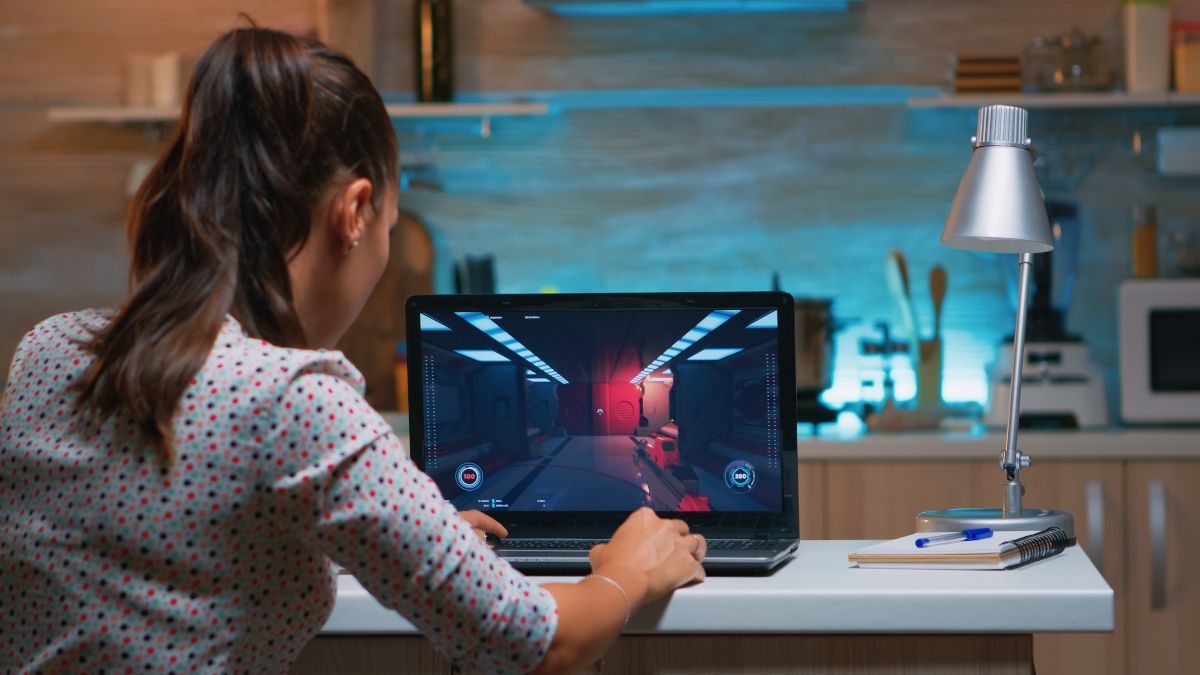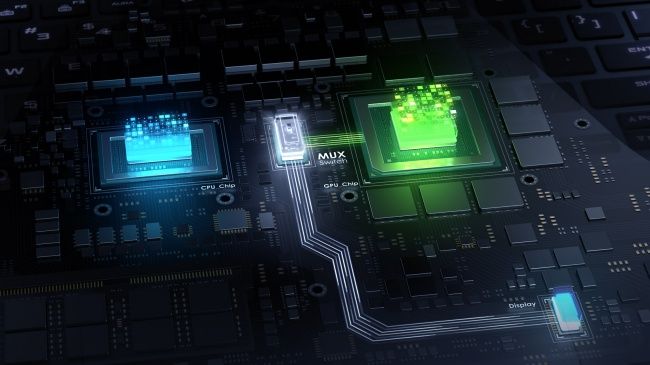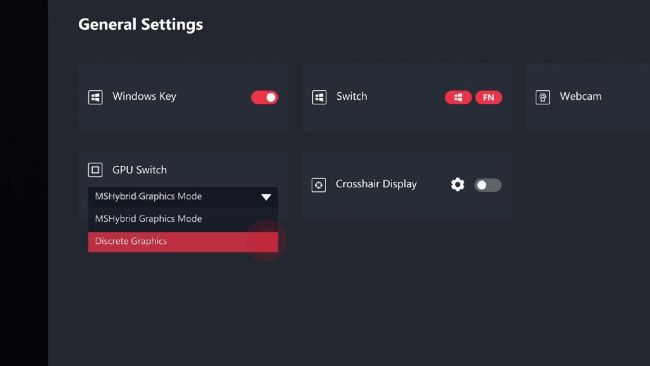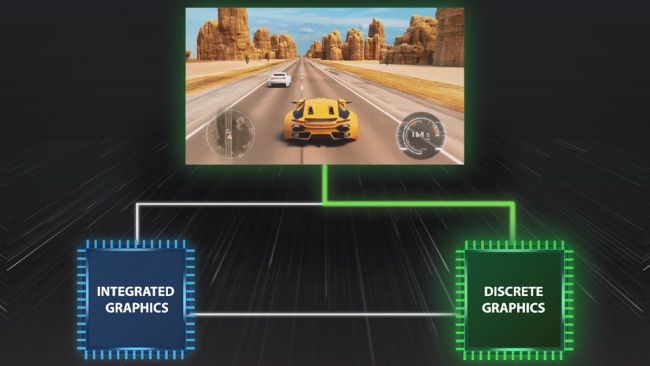Quick Links
If you have looked for a new gaming laptop recently, there is a good chance you have come across a "MUX switch." Here's why it matters and how you can find whether a laptop has a MUX switch.
The Integrated GPU Bottleneck
Most modern gaming laptops have two graphics processors or GPUs---integrated GPU (iGPU) and discrete GPU (dGPU). The iGPU is a part of the CPU, whereas the dGPU is an additional graphics chip that is more powerful than iGPU but consumes far more power. So to balance battery life and graphics performance, the gaming laptops switch between the iGPU and dGPU on the fly. This switching is performed by Optimus (also known as MSHybrid) on laptops with NVIDIA GPU and by Switchable Graphics feature on laptops with AMD GPU.
Although Optimus and its AMD equivalent are beneficial in ensuring the consumers get the best of both the dGPU performance and iGPU battery life, they are not perfect. For example, even when Optimus triggers the dGPU for a graphically intensive task, like a video game, the content rendered by the dGPU is passed through the iGPU. In this approach, the iGPU can become a bottleneck and lead to performance and latency overhead.
To fix the iGPU bottleneck, the gaming laptop manufacturers have introduced the MUX or multiplexer switch.
Bypassing the iGPU
The MUX switch lets consumers enable or disable the iGPU, thus allowing them to route all graphics rendering directly from the dGPU to the laptop display when needed. Although this severely impacts the laptop's battery life, it provides a significant performance increase and lowers latency in games.
The multiplexer switch is a microchip on the laptop's motherboard, which physically changes the connection between dGPU and the display, and it's accompanied by software that allows consumers to communicate with the chip. Unfortunately, as it needs specific hardware to be present in a laptop, you can't simply upgrade your laptop to have a MUX switch.
Moreover, a reboot is required every time you toggle the MUX switch to enable or disable the discrete GPU mode. But it is a small sacrifice to get the reduced latency and increased frame rates. Asus says bypassing the iGPU can result in an average of 9% gain in frame rates. Some games like Rainbow Six Siege and Shadow of Tomb Raider get an even bigger boost of around 30%.
The benefits of a MUX switch aren't just limited to improved graphics performance. It also lets you experience features like NVIDIA G-Sync or higher refresh rates, which are not available with Optimus even when the laptop's dGPU supports them. But, of course, the laptop display also needs to support these features before you can use them with the discrete GPU mode.
How to Check If a Gaming Laptop Has a MUX Switch
If you wonder whether your existing gaming laptop has a MUX switch, there is an easy way to check. Typically all gaming laptops come with built-in software that allows you to tweak various settings of the machine. For example, Asus has Armoury Crate, HP has Omen Gaming Hub, MSI has Dragon Center, and Lenovo has Vantage.
If your laptop has a MUX switch, you'll find a Discrete GPU mode, Dedicated GPU mode, or a toggle to disable the hybrid (MSHybrid) mode in this software application. If there is no such option, you can contact the manufacturer to confirm. Unlike other manufacturers, Dell and Alienware laptops typically have hybrid and dedicated GPU mode settings in their BIOS or UEFI settings screen.
But if you are planning to buy a new gaming laptop and want to confirm MUX switch support, the only way to know is to contact the manufacturer. Unfortunately, MUX switch support is not mentioned in the device's specifications. Checking laptop reviews from reputable publications is another way, but not every review mentions it.
No MUX Switch?
If your laptop doesn't have a MUX Switch, one alternative would be to plug in an external display to your laptop via a DisplayPort or HDMI out port connected directly to the dGPU. This will cause the dGPU to send all the graphics data directly to the external display without passing it through the iGPU. It is essentially the same as how monitors are directly connected to dGPU ports on a desktop.
NVIDIA Optimus and AMD Switchable Graphics vs. MUX Switch
MUX switch and hybrid technologies, like NVIDIA Optimus and AMD Switchable Graphics, are very different in how they work. While Optimus and its AMD counterpart focus on convenience and battery life, the MUX switch is all about getting the best out of the hardware you have paid for.
Both have their advantages and disadvantages. With Optimus and Switchable Graphics, you may have to sacrifice a bit of graphics performance and latency, but you get longer battery life. Additionally, you don't have to worry about fiddling with options every day or every few hours.
On the other hand, with the MUX switch, unless you are switching the dGPU mode on and off with every task, you are sure to see a significant impact on the laptop's battery life. That said, if you are planning to play games while connected to a wall adapter primarily, having the dedicated GPU mode enabled makes sense.
Is There Something Better than a MUX Switch?
Advanced Optimus, which is the evolution of NVIDIA Optimus technology, is emerging as an improvement over the current iteration of the MUX switch. It is basically an automatic MUX switch. Advanced Optimus dynamically switches between iGPU and dGPU. Moreover, since it uses a microchip to physically change the connection between dGPU and display, like a MUX switch, you get the best graphics performance when needed and good battery life when you are doing low-power tasks.
Unfortunately, as of early 2022, Advanced Optimus is only available in a limited number of gaming laptops. So it might take a few years to become as common as a MUX switch.




